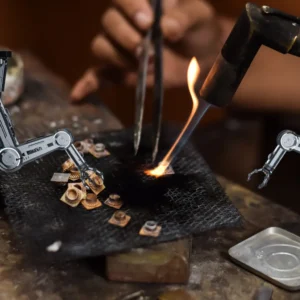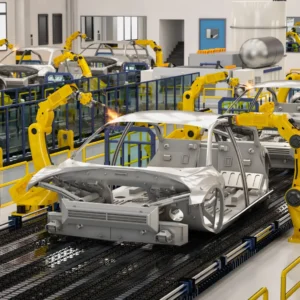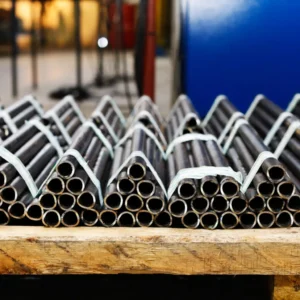
Bricks and Bytes
AI in Construction Material Manufacturing
In this digital age, Artificial Intelligence is not just a buzzword; it’s the driving force behind a construction revolution.
This article takes you through AI’s transformative impact, from enhancing material testing to ushering in green building practices. We’ll uncover how AI is redefining the materials we use and how we build, setting the stage for a more sustainable, efficient, and visionary future.
The construction industry is being revolutionized by AI, shaping our future in ways we never imagined before. Learn more about how AI is transforming the construction industry.
Table of Contents
Enhanced Material Testing with AI
In the dynamic realm of AI in Construction Material Manufacturing, technology is revolutionizing how we test and ensure the quality of construction materials. Gone are the days of tedious, time-consuming manual testing. Precision and efficiency take centre stage thanks to AI in construction material testing.
Machine Learning for material quality assessment lets us scrutinize raw materials and finished products with an eagle eye. Is that concrete mix up to par? AI knows. It can predict weaknesses and strengths, ensuring every brick and beam meets industry standards.
Predictive maintenance in material plants is a game-changer, too. AI’s predictive prowess minimizes downtime by flagging equipment issues before they escalate, streamlining plant operations and ensuring a steady supply of materials.
And what about the logistical marvels? Construction projects can be incredibly complex, with numerous moving parts that need to come together ideally to ensure success.
One of the key challenges in any construction project is managing the supply chain. Efficient materials management is crucial for any construction project but can be challenging. Construction companies can optimize operations and reduce waste with AI-powered supply chains that deliver materials precisely when needed, minimizing costly delays and overruns.
By adopting an AI-optimized supply chain, construction firms can streamline their processes, enhance efficiency, and save significant amounts of money in the long run. Meanwhile, robotics in construction material handling handles the heavy lifting so your workforce can focus on more nuanced tasks.
But the wonder doesn’t stop there. AI-driven architectural material designs push the boundaries of creativity and sustainability, crafting materials tailor-made for eco-friendly construction practices.
As we delve deeper into the AI age in construction, each advancement is a stepping stone toward building a more efficient, sustainable, and visionary future. But now, let’s explore how we can further ensure the impeccable quality of these materials. Are you ready to dive into “Assuring construction material quality”?
Assuring Construction Material Quality
Having ventured into AI-enhanced material testing, we now focus on the critical domain of Assuring Construction Material Quality. How do we ensure that the materials meticulously examined by AI meet the highest standards?
In the dynamic landscape of AI in Construction Material Manufacturing, Machine Learning for material quality assessment plays a pivotal role. It scrutinizes materials for any potential flaws or deviations from the desired specifications. But how does this assessment translate into tangible quality assurance?
The answer lies in the seamless integration of predictive maintenance. By leveraging AI, we identify issues before they escalate and ensure that the production process remains reliable. This, in turn, bolsters the confidence in the quality of materials supplied.
Yet, the pursuit of excellence continues. With an AI-optimized supply chain for construction, materials flow seamlessly from production plants to construction sites, minimizing potential disruptions or delays. The result? A smooth, uninterrupted process that safeguards the integrity of the materials used.
As we navigate the intricate web of quality assurance in AI-driven construction material manufacturing, the focus inevitably shifts to the beating heart of the operation: Efficient Plant Operations. How does AI continue to fine-tune the inner workings of these material plants, ensuring a steady stream of top-notch products? Let’s dive in.
Efficient Plant Operations
Having fortified the foundation of AI in Construction Material Manufacturing, we now focus on the core – Efficient Plant Operations. But how does AI continue to fine-tune the inner workings of these material plants?
In the pursuit of quality assurance, AI doesn’t rest. It optimizes machinery, fine-tuning manufacturing processes with Machine Learning for material quality. This dynamic adaptation minimizes waste, maximizes output, and keeps the plant humming efficiently.
AI unveils its true potential as we delve deeper into the manufacturing heartlands. Potential hiccups are identified and preemptively addressed with predictive maintenance in material plants. This means minimal downtime, increased productivity, and a plant that operates like a well-oiled machine.
Meanwhile, the AI revolution extends beyond the assembly line. Thanks to AI-optimized supply chains, construction plants receive materials precisely when needed. This logistical wizardry ensures that operations are not just efficient but seamless.
Now, let’s step further into the world of AI-powered logistics. How does AI streamline the movement of materials from the plant to the construction site? What role does automation play in this intricate dance? We’re about to uncover the answers in “AI-powered logistics in construction.”
AI-powered Logistics in Construction
As we journey through the intricacies of AI’s role in Construction Material Manufacturing, we reach a critical juncture – AI-powered Logistics in Construction. How does AI optimize the supply chain from manufacturing to construction?
The saga begins with optimizing material flow, thanks to Machine Learning for material quality assessment. AI identifies suitable materials at the right time, mitigating bottlenecks and delays, thus ensuring a constant flow of materials to construction sites.
This logistical marvel extends to AI-optimized supply chains for construction, ensuring that inventory levels are maintained just in time, reducing carrying costs and minimizing waste. Construction sites can receive materials precisely when needed, increasing efficiency.
But the real game-changer is automation. Robotics in construction material handling not only aids in material transportation but also in the construction process itself, further enhancing efficiency and reducing reliance on manual labour.
As we continue to explore the world of automation and its pivotal role, we ask: How does AI further revolutionize material processing within construction? What innovations lie on the horizon? Join us as we unravel the answers in “Automation in Material Processing.”
Automation in Material Processing
Building upon the seamless logistics journey, we now delve into a realm where AI’s transformative power takes centre stage – Automation in Material Processing. But how does AI elevate the processing of construction materials, reshaping the landscape of AI in Construction Material Manufacturing?
With materials arriving like clockwork, AI ensures that processing plants operate at peak efficiency. Predictive maintenance in material plants identifies and addresses potential issues before they disrupt operations, maintaining a smooth processing flow.
Machine Learning, the cornerstone of material quality assessment, is also pivotal in processing. It fine-tunes the machinery to produce consistently high-quality materials, thus reducing waste and maximizing yield.
However, the true magic unfolds with the emergence of AI-driven architectural material designs. AI algorithms create innovative, scalable, customizable materials tailored to specific construction needs. The possibilities are boundless, from self-healing concrete to lightweight, ultra-strong composites.
As we peer into the future, it’s clear that AI is not just the way we process construction but also the materials themselves. How do these advancements impact architectural design and sustainability? Join us in our next “Architectural Advancements with AI Materials” exploration.
Architectural Advancements with AI Materials
As we journey through the transformative landscape of AI in Construction Material Manufacturing, we arrive at a realm where innovation knows no bounds – Architectural Advancements with AI Materials. But how do these materials, shaped by AI-driven designs, redefine the possibilities in construction?
With the groundwork laid in Automation in Material Processing, AI unleashes its creative prowess. Imagine materials that are not just strong but also eco-friendly. AI’s capacity for sustainable design leads to groundbreaking solutions for green construction practices.
The materials designed by artificial intelligence are not limited to traditional ideas. I checked the sentence for spelling, grammar, or punctuation errors. They can be self-healing, adapting to environmental conditions, or even responsive to energy needs. Picture buildings that generate their energy adapt to weather changes, and reduce environmental impact.
Innovations in AI are revolutionizing not only efficiency and sustainability but also aesthetics. By intentionally crafting materials and imitating natural elements, AI transforms how we appreciate visual beauty. Integrating technology and artistry opens up new possibilities in architecture and design.
So, as we explore the architectural horizon shaped by AI materials, we ask: How can these innovations propel the adoption of sustainable, environmentally conscious building practices? Join us in our next revelation, “Green Building Practices through AI,” to unveil the answers.
Green Building Practices through AI
Emerging from the realm of Architectural Advancements with AI Materials, we step into a world where innovation meets sustainability – Green Building Practices through AI. But how does AI-powered construction material manufacturing contribute to a more eco-conscious future?
The fusion of technology and sustainability is evident in the dynamic landscape of AI in Construction Material Manufacturing. AI-designed materials are not just solid and efficient but also environmentally friendly. They can regulate temperature, harness renewable energy, and reduce waste, all while maintaining structural integrity.
The impact extends to construction processes as well. AI-optimized supply chains for construction ensure that eco-friendly materials reach the site efficiently, minimizing carbon footprints. Moreover, the data-driven decision-making capabilities of AI enable builders to make environmentally conscious choices in real-time.
But what about the result? AI facilitates the monitoring and management of buildings, optimizing energy consumption and reducing long-term operational costs. Structures can adapt to changing environmental conditions, maximizing efficiency and minimizing resource wastage.
As we venture deeper into the AI-driven era of construction, we ponder: How can the industry at large adapt to the changing landscape and embrace the full potential of AI? Join us in our next exploration, “Adapting to the AI Age in Construction,” to uncover the transformative possibilities.
Adapting to the AI Age in Construction
The construction industry is on the brink of a paradigm shift thanks to the emergence of AI-powered Green Building Practices. As we adapt to the AI Age, we can revolutionize the construction process and create a more sustainable and efficient future. But how does the construction industry transition into this era of transformative technology?
In the domain of AI in Construction Material Manufacturing, it’s not just about adopting AI solutions; it’s about embracing them fully. Companies must rethink their operations as AI becomes increasingly integrated into every facet of construction, from materials to logistics.
One key aspect is workforce training. Organizations need skilled personnel who can navigate this digital landscape to harness AI’s potential. Training for AI in construction becomes essential to maximize efficiency and innovation.
Moreover, success stories from pioneers in AI and construction can serve as guiding lights. Learning from these success stories in AI construction materials, companies can tailor their strategies to align with industry best practices and innovation.
As we contemplate the path forward, it’s crucial to ask: What are the pillars of success in this AI-driven age of construction? How can companies, big and small, thrive amidst these transformative changes? Join us in our next exploration, “Pillars of Success in AI and Construction,” to uncover the secrets to triumph in this dynamic landscape.
Pillars of Success in AI and Construction
Having explored the transformative journey from Adapting to the AI Age in Construction, we arrive at a crucial juncture – Pillars of Success in AI and Construction. But what are the foundations upon which companies can thrive in the dynamic landscape of AI in Construction Material Manufacturing?
First and foremost, it’s about fostering a culture of innovation. Companies must encourage a mindset that embraces change and actively seeks AI-driven solutions. This cultural shift lays the groundwork for sustainable success.
Education and training are critical. Investing in training for AI in construction ensures that the workforce has the skills to harness AI’s potential. The knowledge base within the organization becomes a wellspring of innovation.
Learning from the success stories in AI construction materials is another pivotal pillar. Understanding how pioneering companies have navigated the AI landscape can guide others towards best practices and strategies that lead to success.
But amidst all this, the crucial question emerges: What lies on the architectural horizon with AI? How will the integration of AI continue to shape the future of construction and materials? Join us in our next exploration, “The Architectural Horizon with AI,” as we venture into the boundless possibilities that await.
The Architectural Horizon with AI
Having journeyed through the pillars of success in AI and construction, we now arrive at the edge of innovation – The Architectural Horizon with AI. But what awaits as we step further into the future of AI in Construction Material Manufacturing?
The transformation brought about by AI is poised to reshape not just how we construct but what we construct. Architects can enjoy unprecedented freedom with AI-driven materials, capable of adapting, self-healing, and responding to environmental changes. Imagine buildings that evolve with their surroundings, optimizing energy usage and occupant comfort.
Furthermore, AI’s capacity for intricate design can unlock architectural marvels. Feasibility of structures once considered impractical is now achievable. I have corrected any spelling, grammar, and punctuation errors. The architectural horizon is limitless, from algorithmically optimized facades to buildings that generate their energy.
However, the journey continues. AI is transforming the way we think about buildings and their purpose. It’s not merely bricks and mortar; it’s a dynamic, responsive entity that adapts to our needs and the planet’s well-being.
As we gaze into this architectural frontier, one question emerges: How will architects, engineers, and builders harness AI to create structures that are not just functional but visionary? Join us in the article’s conclusion as we envision “Building the Future with AI.”
Conclusion
In this journey through the dynamic world of AI in Construction Material Manufacturing, we’ve witnessed a revolution. AI has woven its threads throughout the construction tapestry, from enhanced material testing to green building practices.
We asked how AI could ensure construction material quality, and the answer came with precision through Machine Learning for material quality assessment. Predictive maintenance in material plants provided efficient operations, minimizing downtime and maximizing productivity.
AI-optimized supply chains for construction became the backbone of seamless logistics, while robotics took centre stage in material handling. This automation streamlined the entire process, from production to construction sites.
AI-driven architectural material designs pushed the boundaries of sustainability and creativity, creating materials tailored to eco-friendly practices. It raised the question of how these innovations would impact architectural designs. The answer? A boundless architectural horizon.
As we explored green building practices, it became evident that AI would revolutionize the construction industry’s environmental impact. It offered solutions to reduce waste, harness renewable energy, and optimize resource consumption.
Through the pillars of success in AI and construction, we learned that embracing AI culture, investing in training, and drawing insights from success stories were vital to thriving in this AI age.
Finally, we ventured into the architectural horizon with AI, where structures evolve, respond to their surroundings, and embody visionary design.
Now, as we stand on the cusp of building the future with AI, one question remains: How will we harness the transformative power of AI in construction to create a sustainable, efficient, and visionary world? The answer lies in the hands of those who dare to innovate, adapt, and shape the future.
Related Articles
- AI in Paper Manufacturing: Pulp and Processors
- AI in Agri-Equipment Manufacturing: Fields and Functions
- AI in Footwear Manufacturing: Steps Ahead
- AI in Jewellery Manufacturing: Gems and Generative Models
- AI in Glass Manufacturing: Crystal Clear Computing
- AI in Chemical Manufacturing: Molecular Models
- AI’s Role in Electronic Manufacturing: Circuitry and Systems
- AI’s Revolution in Polymer Production: Reshaping Plastics
- AI in Furniture Manufacturing: Crafted by Code
- AI in Ceramic Production: Fired by Future
- AI in Food Manufacturing: Savory Systems
- AI in Metal Fabrication: Moulded by Machines
- AI in Aerospace Manufacturing: Beyond the Atmosphere
- AI’s Integration in Pharmaceutical Manufacturing: Pills and Processes
- AI in the Automotive Industry: Driving Production
- Weaving AI into Textile Manufacturing: Threads and Tech
- IPA in Manufacturing Sector: How AI Tools Revolutionize Efficiency, Productivity, and Quality

Arindam Roy
An Automation Consultant with 25+ years of IT Experience
Forbes Articles related to AI usage in the Manufacturing Sector:























